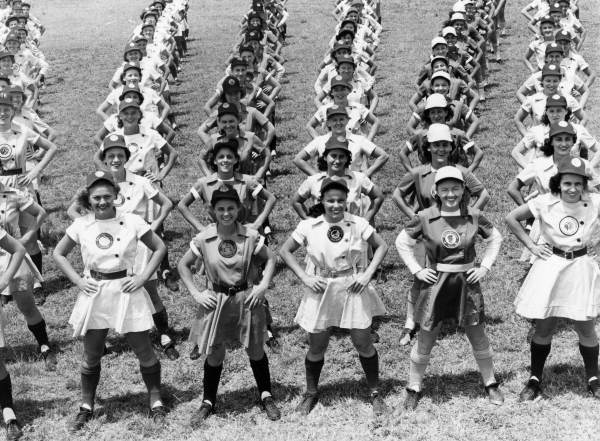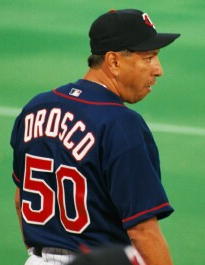|
Mary Weddle
Mary Weddle ''Hines(April 26, 1934 - October 31, 2021) was a former pitcher and utility infielder/outfielder who played in the All-American Girls Professional Baseball League during the season. Listed at , 118 lb, she batted and threw right-handed. Nicknamed ״Giggles״, Mary Weddle proved to be a valuable utility and spot starter during what turned out to be the AAGPBL final season, adding depth at both shortstop and outfield and pitching a complete-game one-hitter. Born in Woodsfield, Ohio, Weddle grew up in a farm and came from a large family of ten brothers and four sisters that had its own baseball team, the Weddle Auctioneers, while her father was a semi-professional pitcher. Weddle played shortstop for a boys baseball team in junior high, but she was not allowed to play with them in high school. She then joined a VFW softball team. She also played softball for the A-1 Queens in Phoenix, Arizona in 1953, before entering the AAGPBL with the Fort Wayne Daisies in ... [...More Info...] [...Related Items...] OR: [Wikipedia] [Google] [Baidu] |
All-American Girls Professional Baseball League
The All-American Girls Professional Baseball League (AAGPBL) was a professional women's baseball league founded by Philip K. Wrigley, which existed from 1943 to 1954. The AAGPBL is the forerunner of women's professional league sports in the United States. Over 600 women played in the league, which eventually consisted of 10 teams located in the American Midwestern United States, Midwest. In 1948, league attendance peaked at over 900,000 spectators. The most successful team, the Rockford Peaches, won a league-best four championships. The 1992 film ''A League of Their Own'' and the 2022 A League of Their Own (2022 TV series), television show of the same name are mostly fictionalized accounts of the league and its stars. Sixty-five original AAGPBL members appeared in scenes for the movie filmed in October 1991 recreating the induction of the league into the National Baseball Hall of Fame and Museum, Baseball Hall of Fame in 1988. History Founding Although the AAGPBL was the firs ... [...More Info...] [...Related Items...] OR: [Wikipedia] [Google] [Baidu] |
Kalamazoo Lassies
The Kalamazoo Lassies were a team who played from through in the All-American Girls Professional Baseball League. The team represented Kalamazoo, Michigan. Home games were initially played at Lindstrom Field, but later games were played at the Catholic Athletic Association Field, now the Soisson-Rapacz field. Kalamazoo uniforms were white (home) and gold (away) with dark green numbers, belt, socks, and cap. History In 1950 the AAGPBL was losing money and fans, and the teams and host cities were changing almost every year. This was a good thing for Kalamazoo as the city was granted the Muskegon Lassies team on a trial basis when the city of Muskegon could no longer support them. The move took place in the middle of the season and the new Kalamazoo Lassies played their first game, still in their Muskegon uniforms, on June 15, 1950 at Lindstrom Field. About 1,400 fans attended the game, which was won by the defending league champion Rockford Peaches, 8–2. The new Lassies post ... [...More Info...] [...Related Items...] OR: [Wikipedia] [Google] [Baidu] |
Walks Plus Hits Per Inning Pitched
In baseball statistics, walks plus hits per inning pitched (WHIP) is a Sabermetrics, sabermetric measurement of the number of Baserunning#Becoming a runner, baserunners a pitcher has allowed per Innings pitched, inning pitched. WHIP is calculated by adding the number of Base on balls, walks and Hit (baseball), hits allowed and dividing this sum by the number of innings pitched.MLB Glossary – Walks and hits per inning pitched (WHIP) ''MLB.com''. Retrieved on September 13, 2016. WHIP reflects a pitcher's propensity for allowing Batting (baseball), batters to reach base, therefore a lower WHIP indicates better performance. While earned run average (ERA) measures the run (baseball), runs a pitcher gives up, WHIP more directly measures a pitcher's effectiveness aga ... [...More Info...] [...Related Items...] OR: [Wikipedia] [Google] [Baidu] |
Strikeout
In baseball or softball, a strikeout (or strike-out) occurs when a batter accumulates three strikes during a time at bat. It means the batter is out, unless the third strike is not caught by the catcher and the batter reaches first base safely as a result. A strikeout is a statistic recorded for both pitchers and batters, and is usually denoted by the letter K, or sometimes by the initialism SO. A " strikeout looking"—in which the batter does not swing and the third strike is called by the umpire—may be denoted by an inverted K (i.e. ꓘ). Although a strikeout suggests that the pitcher dominated the batter, the free-swinging style that generates home runs also leaves batters susceptible to striking out. Some of the most prolific home run hitters of all time (such as Adam Dunn, Mickey Mantle, Reggie Jackson, Alex Rodriguez, and Jim Thome) were notorious for striking out often. Notably, Jackson and Thome respectively hold the major league records for most and second mo ... [...More Info...] [...Related Items...] OR: [Wikipedia] [Google] [Baidu] |
Base On Balls
A base on balls (BB), better known as a walk, occurs in baseball when a batter receives four pitches during a plate appearance that the umpire calls '' balls'', and is in turn awarded first base without the possibility of being called out. The base on balls is defined in Section 2.00 of baseball's Official Rules, and further detail is given in 6.08(a). Despite being known as a "walk", it is considered a faux pas for a professional player to actually walk to first base; the batter-runner and any advancing runners normally jog on such a play. The term "base on balls" distinguishes a walk from the other manners in which a batter can be awarded first base without liability to be put out (e.g., hit by pitch (HBP), catcher's interference). Though a base on balls, catcher's interference, or a batter hit by a pitched ball all result in the batter (and possibly runners on base) being awarded a base, the term "walk" usually refers only to a base on balls, and not the other methods of r ... [...More Info...] [...Related Items...] OR: [Wikipedia] [Google] [Baidu] |
Run (baseball)
In baseball, a run is scored when a player advances around first, second and third base and returns safely to home plate, touching the bases in that order, before three outs are recorded and all obligations to reach base safely on batted balls are met or assured. A player may score by hitting a home run or by any combination of plays that puts him safely "on base" (that is, on first, second, or third) as a runner and subsequently brings him home. Once a player has scored a run, they may not attempt to score another run until their next turn to bat. The object of the game is for a team to score more runs than its opponent. The Official Baseball Rules hold that if the third out of an inning is a force out of a runner advancing to any base then, even if another baserunner crosses home plate before that force out is made, his run does not count. However, if the third out is not a force out, but a tag out, then if that other baserunner crosses home plate before that tag out i ... [...More Info...] [...Related Items...] OR: [Wikipedia] [Google] [Baidu] |
Hit (baseball)
In baseball statistics, a hit (denoted by H), also called a base hit, is credited to a batting (baseball), batter when the batter safely reaches or passes first base after hitting the ball into fair ball, fair territory with neither the benefit of an error (baseball), error nor a fielder's choice. Scoring a hit To achieve a hit, the batter must reach first base before any fielder can either tag out, tag him with the ball, throw to another player protecting the base before the batter reaches it, or force play, tag first base while carrying the ball. The hit is scored the moment the batter reaches first base safely; if he is put out while attempting to stretch his hit to a double (baseball), double or triple (baseball), triple or home run on the same play, he still gets credit for a hit (according to the last base he reached safely on the play). If a batter reaches first base because of offensive interference by a preceding runner (including if a preceding runner is hit by a batt ... [...More Info...] [...Related Items...] OR: [Wikipedia] [Google] [Baidu] |
Innings Pitched
In baseball, the statistic innings pitched (IP) is the number of innings a pitcher has completed, measured by the number of Batter (baseball), batters and baserunners that have been put out while the pitcher is on the Baseball field#Pitcher's mound, pitching mound in a game. Three outs made is equal to one inning pitched. One out counts as one-third of an inning, and two outs as two-thirds of an inning. Sometimes, the statistic is written 34.1, 72.2, or 91.0, for example, to represent innings, innings, and 91 innings exactly, respectively. Runners Glossary of baseball (L)#left on base, left on base by a pitcher are not counted in determining innings pitched. It is possible for a pitcher to enter a game, give up several hits and possibly even several runs, and be removed before achieving any outs, thereby recording a total of zero innings pitched. Alternatively, it is possible for a pitcher to enter a situation where there are two runners on base and no outs. He could throw one p ... [...More Info...] [...Related Items...] OR: [Wikipedia] [Google] [Baidu] |
Earned Run Average
In baseball statistics, earned run average (ERA) is the average of earned runs allowed by a pitcher per nine innings pitched (i.e. the traditional length of a game). It is determined by dividing the number of earned runs allowed by the number of innings pitched and multiplying by nine. Thus, a lower ERA is better. Runs resulting from passed balls, defensive errors (including pitchers' defensive errors), and runners placed on base at the start of extra innings are recorded as unearned runs and omitted from ERA calculations. Origins Henry Chadwick is credited with devising the statistic, which caught on as a measure of pitching effectiveness after relief pitching came into vogue in the 1900s. Prior to 1900 and for many years afterward, pitchers were routinely expected to pitch a complete game, and their win–loss record was considered sufficient in determining their effectiveness. After pitchers like James Otis Crandall and Charley Hall made names for themselves as rel ... [...More Info...] [...Related Items...] OR: [Wikipedia] [Google] [Baidu] |
Win–loss Record (pitching)
In baseball and softball, a win–loss record (also referred to simply as a record) is a statistic that indicates the number of wins (denoted "W") and losses (denoted "L") credited to a pitcher. For example, a 20–10 win–loss record would represent 20 wins and 10 losses. In each game, one pitcher on the winning team is awarded a win (the "winning pitcher") and one pitcher on the losing team is given a loss (the "losing pitcher") in their respective statistics. These pitchers are collectively known as the ''pitchers of record''. The designation of win or loss for a pitcher is known as a ''decision'', and only one pitcher for each team receives a decision. A starting pitcher who does not receive credit for a win or loss is said to have '' no decision''. In certain situations, another pitcher on the winning team who pitched in relief of the winning pitcher can be credited with a save, and holds can be awarded to relief pitchers on both sides, but these are never awarded to the ... [...More Info...] [...Related Items...] OR: [Wikipedia] [Google] [Baidu] |
Games Pitched
In baseball statistics, games pitched (denoted by Games G in tables of only pitching statistics) is the number of games in which a player appears as a pitcher. The statistic is also referred to as appearances, especially to refer to the number of games a relief pitcher has pitched in. Normally, a pitcher must face at least one batter (or three batters in some relief situations), but exceptions are made in the case of injury. A notable example was Larry Yount, who suffered an injury while throwing warmup pitches after being summoned as a reliever in a Major League Baseball (MLB) game on September 15, 1971. He did not face a batter, but was credited with an appearance because he had been announced as a substitute. Yount never appeared in (or actually played in) any other MLB game. Major League Baseball career leaders Listed below are all MLB players with at least 1,000 games pitched. The first player to reach the mark was Hoyt Wilhelm, in May 1970. LaTroy Hawkins is the most rece ... [...More Info...] [...Related Items...] OR: [Wikipedia] [Google] [Baidu] |
Cooperstown, New York
Cooperstown is a village in and the county seat of Otsego County, New York, United States. Most of the village lies within the town of Otsego, but some of the eastern part is in the town of Middlefield. Located at the foot of Otsego Lake in the Central New York Region, Cooperstown is approximately west of Albany, southeast of Syracuse and northwest of New York City. The population of the village was 1,794 as of the 2020 census. Cooperstown is the home of the National Baseball Hall of Fame and Museum. The Fenimore Farm & Country Village in the village opened in 1944 on farmland that had once belonged to James Fenimore Cooper. The Fenimore Art Museum and Glimmerglass Opera are also based here. Most of the historic pre-1900s core of the village is included in the Cooperstown Historic District, which was listed on the National Register of Historic Places in 1980; its boundaries were increased in 1997 and more contributing properties were identified. History Native Ame ... [...More Info...] [...Related Items...] OR: [Wikipedia] [Google] [Baidu] |






